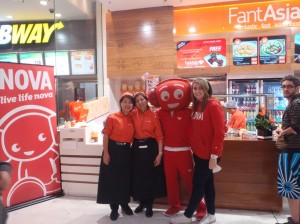An estimated 55 million to 105 million persons in the United States experience acute gastroenteritis caused by foodborne illness each year, resulting in costs of $2–$4 billion annually (1).
 Many persons do not seek treatment, resulting in underreporting of the actual number of cases and cost of the illnesses (2). To prevent foodborne illness, local health departments nationwide license and inspect restaurants (3) and track and respond to foodborne illness complaints. New technology might allow health departments to engage with the public to improve foodborne illness surveillance (4). For example, the New York City Department of Health and Mental Hygiene examined restaurant reviews from an online review website to identify foodborne illness complaints (5). On March 23, 2013, the Chicago Department of Public Health (CDPH) and its civic partners launched FoodBorne Chicago (6), a website (https://www.foodbornechicago.orgExternal Web Site Icon) aimed at improving food safety in Chicago by identifying and responding to complaints on Twitter about possible foodborne illnesses. In 10 months, project staff members responded to 270 Twitter messages (tweets) and provided links to the FoodBorne Chicago complaint form.
Many persons do not seek treatment, resulting in underreporting of the actual number of cases and cost of the illnesses (2). To prevent foodborne illness, local health departments nationwide license and inspect restaurants (3) and track and respond to foodborne illness complaints. New technology might allow health departments to engage with the public to improve foodborne illness surveillance (4). For example, the New York City Department of Health and Mental Hygiene examined restaurant reviews from an online review website to identify foodborne illness complaints (5). On March 23, 2013, the Chicago Department of Public Health (CDPH) and its civic partners launched FoodBorne Chicago (6), a website (https://www.foodbornechicago.orgExternal Web Site Icon) aimed at improving food safety in Chicago by identifying and responding to complaints on Twitter about possible foodborne illnesses. In 10 months, project staff members responded to 270 Twitter messages (tweets) and provided links to the FoodBorne Chicago complaint form.
A total of 193 complaints of possible foodborne illness were submitted through FoodBorne Chicago, and 133 restaurants in the city were inspected. Inspection reports indicated 21 (15.8%) restaurants failed inspection, and 33 (24.8%) passed with conditions indicating critical or serious violations. Eight tweets and 19 complaint forms to FoodBorne Chicago described seeking medical treatment. Collaboration between public health professionals and the public via social media might improve foodborne illness surveillance and response. CDPH is working to disseminate FoodBorne Chicago via freely available open source software
FoodBorne Chicago tracked Twitter messages using a supervised learning algorithm (7). The algorithm parsed tweets originating from Chicago that included “food poisoning” to identify specific instances of persons with complaints of foodborne illness. The geographic boundaries used by the algorithm also included some neighboring Chicago suburbs. However, follow-up inspections were conducted only at restaurant locations within the city limits. Tweets identified by the algorithm were reviewed by project staff members for indications of foodborne illness (e.g., stomach cramps, diarrhea, or vomiting) from food prepared outside the home. Project staff members provided feedback on whether each tweet fit the criteria, enabling the tweet identification algorithm to learn and become more effective over time.
 For tweets meeting the criteria, project staff members used Twitter to reply. For example, Tweet: “Guess who’s got food poisoning? This girl!” Reply: “That doesn’t sound good. Help us prevent this and report where you ate here (link to Foodborne Chicago and a web form to report the illness).” The information in submitted forms went directly into the Chicago 311 system that handles all requests for nonemergency city services. Descriptive statistics were used to evaluate FoodBorne Chicago over its first 10 months of use and to compare the results of complaint-based health inspections of food establishments resulting from FoodBorne Chicago use with health inspections of food establishments based on complaints not submitted through FoodBorne Chicago. The comparisons did not include reinspections or routine inspections not based on a complaint.
For tweets meeting the criteria, project staff members used Twitter to reply. For example, Tweet: “Guess who’s got food poisoning? This girl!” Reply: “That doesn’t sound good. Help us prevent this and report where you ate here (link to Foodborne Chicago and a web form to report the illness).” The information in submitted forms went directly into the Chicago 311 system that handles all requests for nonemergency city services. Descriptive statistics were used to evaluate FoodBorne Chicago over its first 10 months of use and to compare the results of complaint-based health inspections of food establishments resulting from FoodBorne Chicago use with health inspections of food establishments based on complaints not submitted through FoodBorne Chicago. The comparisons did not include reinspections or routine inspections not based on a complaint.
During March 2013–January 2014, FoodBorne Chicago identified 2,241 “food poisoning” tweets originating from Chicago and neighboring suburbs. From these, project staff members identified 270 tweets describing specific instances of persons with complaints of foodborne illness. Eight of the 270 tweets (3.0%) mentioned a visit to a doctor or an emergency department. A total of 193 complaints of food poisoning were submitted through the FoodBorne Chicago web form. However, project staff members were not able to track how many of the 193 came from persons led to the form via Twitter and how many came from persons who visited the FoodBorne Chicago site on their own.
Of the 193 FoodBorne Chicago complaints, 19 (9.8%) persons indicated they sought medical care. The complaints identified 179 Chicago restaurant locations; at 133 (74.3%) locations, CDPH inspectors conducted unannounced health inspections. These 133 inspections amounted to 6.9% of the 1,941 health inspections of food establishments prompted by complaints during the study period. Of the 133 FoodBorne Chicago–prompted health inspections, 122 (91.7%) inspection reports identified at least one health violation, compared with 91.8% of inspection reports following complaints filed outside of FoodBorne Chicago during the same period.
Of the 133 FoodBorne Chicago–prompted health inspections 27 (20.3%) identified at least one critical violation, compared with 16.4% of the 1,808 inspections not prompted by FoodBorne Chicago. Critical violations indicate an “immediate health hazard” resulting in a high risk for foodborne illness. Critical violations must be fixed while the inspector is present or the restaurant fails inspection, has its license suspended, and is closed.* Twenty-nine restaurants (21.8%) reported via FoodBorne Chicago had at least one serious violation compared with 27.8% of restaurants not reported via FoodBorne Chicago. Serious violations indicate a “potential health hazard” that must be corrected within a timeframe determined by the health inspector, typically 5 days. If the serious violation is not fixed on re-inspection, the license is suspended, and the business is closed. Overall, at least one critical or serious violation was found in 37.6% of inspections prompted by FoodBorne Chicago and 37.2% of inspections from other complaints during the same period.
Some differences were noted in the distribution of specific violations between FoodBorne Chicago inspections and other complaint inspections. For example, 13.5% of FoodBorne Chicago inspections resulted in (critical) violation 3 (i.e., food not stored at appropriate temperatures), compared with 8.2% of other complaint inspections (Table). In addition, 14.3% of other complaint inspections reported (serious) violation 18 (i.e., food not protected from contamination), compared with 6% of FoodBorne inspections.
A total of 21 (15.8%) of the 133 restaurants reported through FoodBorne Chicago failed inspection and were closed; an additional 33 restaurants (24.8%) passed with conditions, indicating that serious or critical violations were identified and corrected during inspection or within a specified timeframe. Of the inspected restaurants with complaints not reported through FoodBorne Chicago, 25.8% failed and 14.2% passed with conditions. During the study period, among all restaurants inspected, FoodBorne Chicago–prompted inspections accounted for 4.3% of failed inspections and 11.4% of pass with conditions inspections.
Centers for Disease Control and Prevention
Jenine K. Harris, PhD, Raed Mansour, MS, Bechara Choucair, MD, Joe Olson, Cory Nissen, MS, Jay Bhatt, DO
http://www.cdc.gov/mmwr/preview/mmwrhtml/mm6332a1.htm?s_cid=mm6332a1_x
 The inquiry by Chris Elliott, professor of food safety at Queen’s University Belfast, was announced by the Department for Environment, Food and Rural Affairs 16 months ago and was to have been completed by the spring. It is expected to highlight the impact of spending cuts on frontline enforcement and inspection in the food industry.
The inquiry by Chris Elliott, professor of food safety at Queen’s University Belfast, was announced by the Department for Environment, Food and Rural Affairs 16 months ago and was to have been completed by the spring. It is expected to highlight the impact of spending cuts on frontline enforcement and inspection in the food industry.







